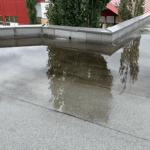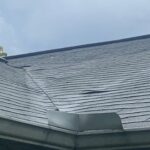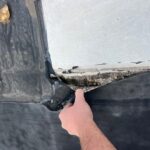Cleaning gutters is no fun at all! However, not everyone agrees that gutter guards are worth the cost, time, and effort to get them installed. If you want to spend less time cleaning your gutters, gutter guards are definitely worth considering.
Just don’t expect that they will be maintenance free.
Some debris will inevitably collect on top of the gutter guards themselves. However, it should be much easier and quicker to clean it off the top than to dig into clogged gutters to remove handfuls of leaves, seeds, and twigs. That said, some gutter guard systems are harder to clean once they become clogged. So choose your gutter guard system wisely!
In some cases, the cost of the gutter guard system can cost more than several years’ worth of professional gutter cleaning. Therefore, depending on your situation and how many trees are around your home, it may make more sense to pay a professional to clean your gutters annually instead of paying for a gutter guard system that may fail.
Also, if you have a house with gutters that are 2 or 3 stories tall, you should consider hiring a gutter cleaning service for once or twice a year cleaning anyway — whether you have gutter guards or not. It’s too dangerous to clean gutters that high off the ground.
A gutter guard system helps prevent clogs and keeps the guttering system working smoothly for a longer period time before it will need to be replaced. There are several types of gutter guard systems and this list of pros and cons will help you select the one that’s right for your home.
Metal Screens
This is a popular do-it-yourself choice. The screens look similar to chicken wire and are made of metal or galvanized steel and are relatively easy to install.
The metal screens do allow some organic matter to enter the gutters and periodic cleaning will still be needed.
Plastic Screens
Another popular choice for do-it-yourselfers and less expensive than metal screens. The plastic screens will allow small debris to enter the gutters, plus the holes in the screens catch debris and become clogged. Regular cleaning will still be needed.
Reverse Curve
The tried and true design that most big-name gutter installing companies use. The reverse curve style comes in both metal or plastic and consists of a round sheet of metal which guides water into the gutters while deflecting debris away from the gutters. Some organic matter will still get past the reversed curve gutter guards and into gutters, so cleaning will still be needed periodically.
In a future post, we will discuss, gutter guards – what works and what doesn’t.
Reverse Curve with Waterfall
This gutter guard system consists of 1-3 parallel slots to create a waterfall effect as the rain water runs down the roof and through the gutters. Typically made from recycled plastic, this gutter guard system will need to be cleaned periodically.
Sponges or Pipe Cleaners
Labor intensive at cleaning time. Either system requires you to place the s or pipe cleaners in the gutter to catch falling debris. Either type must be removed periodically and shaken to remove captured debris, then placed back into cleaned gutters.
Mirco-Mesh
Considered to be the best type of gutter guard, but it must be installed by professionals. The micro-mesh guards are made of stainless steel, have holes smaller than the size of sewing needles and allow no debris to enter the gutters.
The design allows rain water to continue to enter the gutters even when debris is laying on top of the micro-mesh. And when the rain ends, the slightest breeze will blow away whatever debris has fallen onto the mesh. An occasional brushing is all that’s needed to maintain the system after installing micro-mesh gutter guards.
In a future post, we will discuss what works and what doesn’t work with regard to gutter guards.





